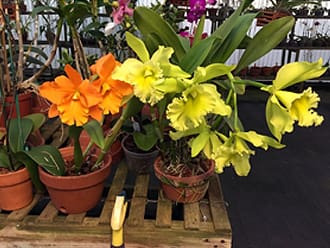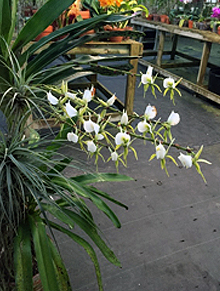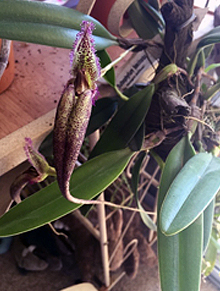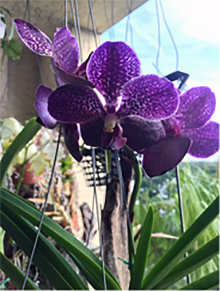 Emily, a Landscape Design Assistant here at Gill’s, loves orchids. Before joining us, she worked at the Naples Botanical Gardens in Naples, Florida, growing orchids. Emily, pictured here, shares her knowledge – enjoy!
Emily, a Landscape Design Assistant here at Gill’s, loves orchids. Before joining us, she worked at the Naples Botanical Gardens in Naples, Florida, growing orchids. Emily, pictured here, shares her knowledge – enjoy!
Orchidacaea is the largest flowering plant family in the world. This family has more than 25,000 documented species which is about four times the number of mammal species in the world today! The Royal Horticultural Society estimates that we are close to nearing half a million hybridized varieties, along with new orchids being created in labs or discovered every day.
 Orchids are a very diverse plant species as they occur naturally on every continent except Antarctica. They can grow as epiphytes which attach to trees, lithophytes which attach to rocks, or terrestrial which grow in the ground like most plants. They are known for being the tropical, bright-colored beauties in the rainforests and they are also known for being the state flower of Minnesota – the Showy Lady’s slipper. Orchids also occur in every color except for true black or true blue – if you see these colors it is likely that they are either dyed or you are seeing a very vibrant spectrum of purple.
Orchids are a very diverse plant species as they occur naturally on every continent except Antarctica. They can grow as epiphytes which attach to trees, lithophytes which attach to rocks, or terrestrial which grow in the ground like most plants. They are known for being the tropical, bright-colored beauties in the rainforests and they are also known for being the state flower of Minnesota – the Showy Lady’s slipper. Orchids also occur in every color except for true black or true blue – if you see these colors it is likely that they are either dyed or you are seeing a very vibrant spectrum of purple.
 Perhaps the most beneficial orchid is Vanilla planifolia – the vanilla plant. This is a vining species whose roots start in the ground and began to attach to a tree and vine to the top. When this orchid flower is pollinated and creates a seed pod, the seeds are the little black specs that you see in your vanilla bean ice cream! This is the only orchid that is being farmed for industrial purposed in the food and cosmetic industry.
Perhaps the most beneficial orchid is Vanilla planifolia – the vanilla plant. This is a vining species whose roots start in the ground and began to attach to a tree and vine to the top. When this orchid flower is pollinated and creates a seed pod, the seeds are the little black specs that you see in your vanilla bean ice cream! This is the only orchid that is being farmed for industrial purposed in the food and cosmetic industry.
 The one thing that almost every orchid species has in common is their floral arrangement: The outer three flower parts are sepals and the inner three flower parts are beautifully colored petals. A fun fact is that a study has been done to prove that humans have such a fascination with orchids because the orchid flower has bilateral symmetry – like a human face – which makes humans have an affinity to caring for them. It has been said that “When someone looks at an orchid, it looks back at you.”
The one thing that almost every orchid species has in common is their floral arrangement: The outer three flower parts are sepals and the inner three flower parts are beautifully colored petals. A fun fact is that a study has been done to prove that humans have such a fascination with orchids because the orchid flower has bilateral symmetry – like a human face – which makes humans have an affinity to caring for them. It has been said that “When someone looks at an orchid, it looks back at you.”
Orchids can see out of reach for many of us as they are one of the oldest plants to live on Earth – over ten million years! On average they take seven years to grow from seed to flower! And people have been known to catch “orchid fever” when collecting them (read the book Orchid Fever by Eric Hansen!) But, it is important to not became intimidated by orchids. In fact, they require a certain amount of neglect in order for them to grow happily. Here are some tips for growing your own orchid collection:
- Here in Corpus Christi, you can grow your orchids outside year round – only needing to bring them inside if the temperature is going to drop below 40 degrees, or 45 if you want to play it safe.
- Keeping in mind that most of the orchids you will find for sale grow epiphytically on tree trunks, they receive dappled light under the tree canopy. Try to mimic that environment always. If you are growing indoors, Eastern facing light is always best as it is the cool, bright light of the morning.
- Next, think again of the natural environment of your orchid. The root systems are exposed in nature and not potted. A good way to mimic this is to water once a week by leaching the pot, allowing the water to drain through the bottom for a few minutes. Never let your orchid sit in water as this will rot its roots – this would never happen in nature because after a rain storm the wind would dry the orchid’s roots. Air flow is vital to the health of your orchid.
- Fertilizing your orchid should be thought of as giving a vitamin supplement. You should not fertilize with the intention of encouraging blooming. You will want to feed a balanced fertilized, like Fertilome Water Soluble Plant Food 20-20-20, and remember the “weekly/weakly” solution: feed fertilizer once a week at a 50% dilution rate.
- Pest control is best done with a preventative mindset rather than waiting until you have a problem to treat it. I believe the best preventative is neem oil (Natural Guard Neem Ready To Use) – this is an organic treatment that you can apply to your orchids twice a month. The crucial part of applying neem oil is to be sure to never apply it in temperatures over 85 degrees or in the sunlight as it can burn the leaves of your plants. The best solution is to spray in the evenings so that it has all night to dry.
- Repotting your orchid should only occur when your plant’s roots began growing over the side and attaching to the pot. It is normal to have aerial roots that stick out of the pot. Simply remove your orchid from the pot, throw away all of the old bark or sphagnum moss mixture, clean up the roots by pulling dead roots away with your hands (try to avoid cutting anything) and then re-pot in a bark mixture.
- A special note on Phalaenopsis, the most popular orchid kept as a houseplant, is that this particular orchid does part of its photosynthetic process through its roots – this makes it very important to keep it potted in a clear plastic container so that its roots can see the light
Please take some time to enjoy some of the beautiful orchids in my life and find some inspiration to be patient with yours!



 –Emily
–Emily

 Emily, a Landscape Design Assistant here at Gill’s, loves orchids. Before joining us, she worked at the Naples Botanical Gardens in Naples, Florida, growing orchids. Emily, pictured here, shares her knowledge – enjoy!
Emily, a Landscape Design Assistant here at Gill’s, loves orchids. Before joining us, she worked at the Naples Botanical Gardens in Naples, Florida, growing orchids. Emily, pictured here, shares her knowledge – enjoy!

Sharon Schneider says
confused about the plastic containers that comes around the plant. Do they really need to have it. I have one that shows white roots. It also has green roots. white roots are at the bottom. What to do?
Erica says
Do ya’ll have lady slipper orchids or Vanda orchids? My mother lives in Corpus so she could pick them up.
Thank you!
Heather Holden says
Looking for monkey face orchid
brenda says
do you have vanilla orchids?
DeAnna Baumgartner says
We do not carry vanilla orchids at this time, although we have had them in the past. Please get back with me in the Fall or Spring to see if we are able to find them available at that time.